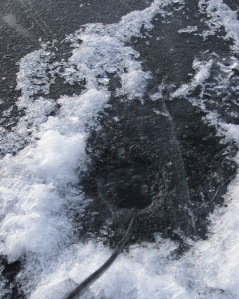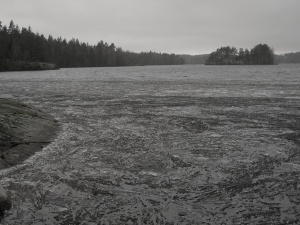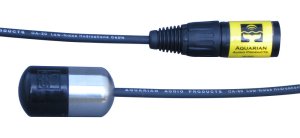Last week I had some chances to capture sounds of ice down by the lake, this time from some different perspectives.

First out is a recording I made last Saturday with my NT1-A’s in a stereo array. It’s recorded just after midnight. The conditions were good, with temperatures dropping to below -15° Celsius and no wind. The only disturbing element were an aircraft that just wouldn’t go away. I tried to wait it out for more than an hour but finally gave in and made the recording anyway, hence the low-frequency hum coming from the right. As in the case with my earlier ice recording this year I did some cut and paste this time as well, the original recording spans about 30 minutes. I really find some of these sounds to be very nightmarish.
Please use headphones
Geek note: 2xRøde NT1-A’s (ORTF, 17cm spacing, angled 110°)-> Sound Devices 702
The other three recordings were made yesterday. As me and Matilda were on our way home after a day of ice skating on the lake I noticed some intense ice movements. At home I switched the skating gear in favour of the recording gear and then headed back down to the lake. The sun was setting as I arrived and some guys that had been out ice fishing on the middle of the lake were leaving. So I went over there and used one of their holes to get below the sheet of ice with my hydrophone. These recordings are not manipulated in any way, the activity going on where so intense I could actually feel the ice moving underneath me.

First of is a short recording made with the hydrophone as a contact mic. As you probably notice the microphone’s self noise is very evident due to high gain:
Geek note: Aquarian H2a (+contact mic adapter) -> Sound Devices 702
In the second recording the hydrophone is lowered about 10 cm’s into the water, centering it in the 20 cm thick layer of ice. Be advised that some of the sounds in this recording are very loud.
Geek note: Aquarian H2a -> Sound Devices 702
In the last recording the hydrophone is lowered about 1 meter into the water, positioning it about 40 cm’s below the sheet of ice.
Geek note: Aquarian H2a -> Sound Devices 702
Of these three hydrophonic recordings I’m most fond of the last one as you’re able to hear distant sounds as well as close by cracks very clearly. It’s also a bit warmer to the tone than the second one. I just wish I had a second hydrophone for stereo recordings.









